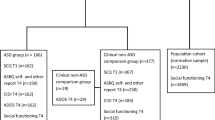Abstract
The social behaviors of 14 autistic children and 14 normal children of equivalent mental age were observed during a free-play situation as well as during separation from and reunion with their mothers and a stranger. As a group, the autistic children showed evidence of attachment to their mothers, directing more social behaviors and more physical contact to their caregivers than to the stranger during the reunion episodes. Within the autistic group, the children who showed an increase in attachment behaviors in response to separation and reunion demonstrated more advanced symbolic play skills than those autistic children who showed no change in attachment behaviors. One possible explanation may be that autistic children require more advanced levels of symbolic ability to form attachments to others than is necessary for the development of attachments in normal children.
Similar content being viewed by others
References
Ainsworth, M. D. S., & Bell, S. M. (1970). Attachment, exploration, and separation: Illustrated by the behavior of one-year-olds in a strange situation.Child Development, 41, 49–67.
Ainsworth, M. D. S., Blehar, M. C., Waters, E., & Wall, S. (1978).Patterns of attachment: A psychological study of the strange situation. Hillsdale, New Jersey: Erlbaum.
American Psychiatric Association.Diagnostic and statistical manual of mental disorders (3rd ed.), DSM III. Washington, D.C.: Author.
Beckwith, L., & Thompson, S. (1976). Recognition of verbal labels of pictured objects and events by 17- to 30-month-old infants.Journal of Speech and Hearing Research, 19, 690–699.
Bettelheim, B. (1967).The empty fortress: Infantile autism and the birth of the self. New York: Free Press.
Bowlby, J. (1969).Attachment and loss. New York: Basic Books.
Cantwell, D. P., Baker, L., & Rutter, M. (1978). Family factors. In M. Rutter & E. Schopler (Eds.),Autism: A reappraisal of concepts and treatment (pp. 269–296). New York: Plenum Press.
Curcio, F. (1978). Sensorimotor functioning and communication in mute autistic children.Journal of Autism and Childhood Schizophrenia, 8, 281–292.
Goldfarb, W. (1970). Childhood psychosis. In P. A. Mussen (Eds.),Carmichael's manual of child psychology (3rd ed.). New York: Wiley.
Kanner, L. (1943). Autistic disturbances of affective contact.Nervous Child, 2, 217–250.
Lord, C. (1984). Peer relations in autism. In F. J. Morrison, C. Lord, & D. P. Keating (Eds.),Applied developmental psychology (Vol. 1, pp. 165–229). New York: Academic Press.
Martini, M. (1980). Structures of interaction between two autistic children. In T. Field, S. Goldberg, D. Stein, & A. M. Sostak (Eds.),High-risk infants and children: Adult and peer interaction. New York: Academic Press.
McHale, S. M., Simeonsson, R. J., Marcus, L. M., & Olley, J. G. (1980). The social and symbolic quality of autistic children's communication.Journal of Autism and Developmental Disorders, 10, 299–310.
McHale, S. M., Simeonsson, R. J., Olley, J. G., & Marcus, L. M. (1980, March 12–14).Social interaction of autistic children. Paper presented at the Thirteenth Annual Gatlinberg Conference on Research in Mental Retardation and Developmental Disabilities, Gatlinberg, Tennessee.
Piaget, J. (1952).The origins of intelligence in children. New York: International Universities Press.
Rutter, M. (1978a). Diagnosis and definition of childhood autism.Journal of Autism and Childhood Schizophrenia, 8, 139–161.
Rutter, M. (1978b). Language disorder and infantile autism. In M. Rutter & E. Schopler (Eds.),Autism: A reappraisal of concepts and treatment (pp. 85–104). New York: Plenum Press.
Sigman, M., & Ungerer, J. A. (1981). Sensorimotor skills and language comprehension in autistic children.Journal of Abnormal Child Psychology, 9, 149–165.
Sigman, M., & Ungerer, J. A. (1984). Cognitive and language skills in autistic, mentally retarded, and normal children.Developmental Psychology, 20, 293–302.
Ungerer, J. A., & Sigman, M. (1981). Symbolic play and language comprehension in autistic children.Journal of the American Academy of Child Psychiatry, 20, 318–337.
Ungerer, J., Zelazo, P., Kearsley, R., & O'Leary, L. (1981). Developmental changes in the representation of objects in symbolic play from 18 to 34 months of age.Child Development, 52, 186–195.
Vaughn, B., Egelund, B., Sroufe, L. A., & Waters, E. (1979). Individual differences in infant-mother attachment at twelve and eighteen months: Stability and change in families under stress.Child Development, 50, 971–975.
Waters, E., Wippman, J., & Sroufe, L. A. (1979). Attachment, positive affect and competence in the peer group: Two studies in construct validation.Child Development, 50, 821–829.
Watson, M., & Fischer, K. (1977). A developmental sequence of agent use in late infancy.Child Development, 48, 828–836.
Weinraub, M., & Lewis, M. (1977). The determinants of children's responses to separation.Monographs of the Society for Research in Child Development, 42 (4, Serial No. 172).
Wing, L. (1981). Language, social, and cognitive impairments in autism and severe mental retardation.Journal of Autism and Developmental Disorders, 11, 31–44.A1260007 00002 CS-SPJRNPDF [HEADSUP]
Author information
Authors and Affiliations
Additional information
Support for this research was provided by Biobehavioral Research Support Grant 516, Grant MH 33815, and NIMH Postdoctoral Fellowship 1 F32 MHO7550-01. Subjects were recruited from the UCLA Clinical Research Center for the Study of Childhood Psychosis, funded by NIMH Grant MH 30897. We thank members of the CRC, particularly Dr. Peter Tanguay, Dr. Barbara Fish, and Dr. B. J. Freeman, for their support of our research efforts. We also thank Mary Beth Sorensen for her assistance in data collection and analysis, Luisa Castillo for her help in preparation of the manuscript, and Dolores Adams for her assistance in data analysis. In addition, Brian Vaughn, Ph.D., Peter Mundy, Ph.D., and Tracy Sherman, Ph.D., contributed significantly to this project. Portions of this paper were presented at the Annual Meeting of the American Academy of Child Psychiatry, Washington, D.C., 1982.
Rights and permissions
About this article
Cite this article
Sigman, M., Ungerer, J.A. Attachment behaviors in autistic children. J Autism Dev Disord 14, 231–244 (1984). https://doi.org/10.1007/BF02409576
Issue Date:
DOI: https://doi.org/10.1007/BF02409576




